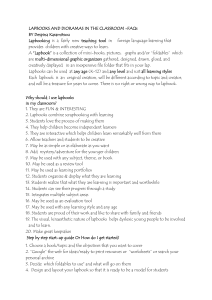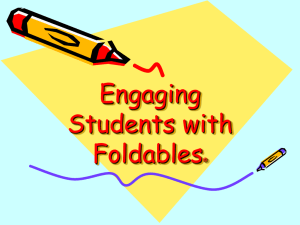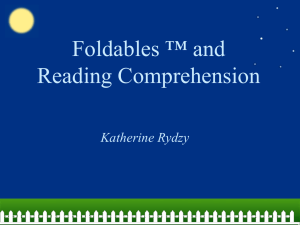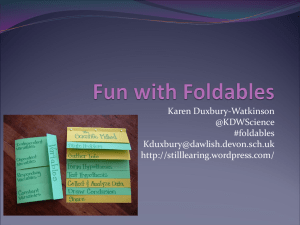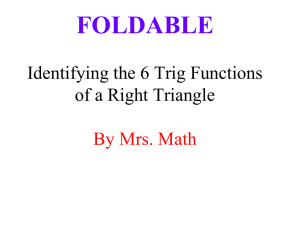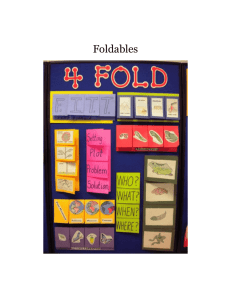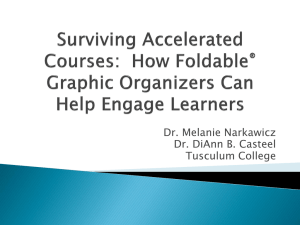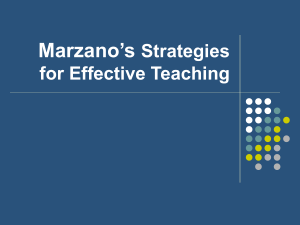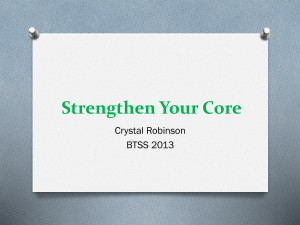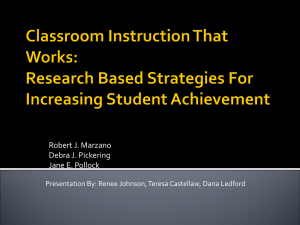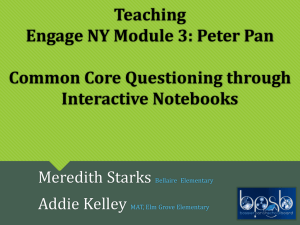Foldables for the Middle-High School Presentation
advertisement
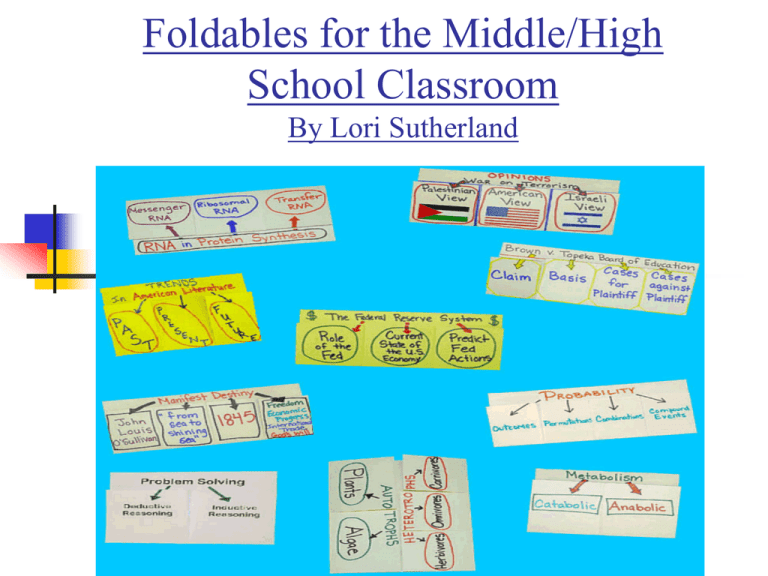
Foldables for the Middle/High School Classroom By Lori Sutherland What are foldables? Foldables are three-dimensional, interactive graphic organizers that can help your students to organize, remember, review, and learn information. They are also a learning/assessment tool for teachers. What concepts can foldables be used for? From vocabulary words to content specific concepts that are hard to teach, foldables give students the opportunity to become more involved in their learning with a handson approach to your curriculum. Sample Usage: Introducing new vocabulary words Introducing a new skill, topic, or concept Before a chapter, lesson, story, etc. During the lesson After completing the chapter, lesson, story, etc. Guided Instruction or Guided Reading Writing process Review Anytime- daily Why use foldables in my class? Foldables can increase achievement and interest levels in any content area for all middle/high school students, regardless of age. Why use foldables continued... Fun & motivating, hands-on approach to learning. As a study guide. Note taking to help organize information. Reach all learners (Visual, Kinesthetic, Spacial, etc.). Students retain information. Alternative assessments. Replace the use of worksheets/reduce copy counts. Projects. Integration of subject areas, including the arts. Improve student note-taking skills. Hold students accountable for content specific knowledge. Research tells us that graphic organizers, such as foldables: Help students focus on text structure as they read by: providing tools used to visually represent relationships in text helping students write well-organized summaries of text (Putting Reading First: The Research Building Blocks for Teaching Children to Read) Students are actively engaged in the instructional process and learning as they create foldables: Classroom Instruction That Works: Research Based Strategies for Increasing Student Achievement by Robert Marzano strategies are integrated (identification of similarities & differences, summarizing & note-taking, nonlinguistic representations, questions, cues, and advanced organizers, etc.) Marzano’s Taxonomy Bloom’s Taxonomy Note Taking research... Effective note taking can make the difference between passing and failing ( Hughes & Suritsky, 1994) Independent note taking increases active participation in the learning process, leading to improvement in memory of information ( Ruhl & Suritsky, 1995) Listening and then receiving notes is not as effective as taking one’s own notes. (Carrier, 1983; Hartley, 1983; Katayama & Robinson, 2000) Graphically organized notes teach more than just the facts as they increase student involvement with the information, increasing higher order thinking (Robinson et. al., 1998) Students had a 34 percentile gain when taught how to summarize information and take effective notes. (Robert J. Marzano, Classroom Strategies that Work) How should we use foldables? • • • • Teacher directed, modeling Guided practice Alternative assessments Independent practice-students can create their own folds/projects Bloom-Marzano Hybrid Taxonomy: North Carolina Thinking Skills Levels Knowing Organizing Applying Who did? Categorize... Give an instance which ___ When was? Classify... What is? Where? How is __ like or different? Identify... Contrast... Describe... Compare... Match... Recall... Put in order... Reorganize __ by __ Represent __ by __ How would you use...? Since you know __, how would you...? How would you illustrate...? How is __ an example of __? Analyzing What are the attributes of __? What evidence is there for __? What are the parts of __? How do the parts relate? What are the main ideas? What is the conclusion? What caused? Generating Integrating Evaluating How many ways can you think of to __? Create a plan to __ Summarize.. What would happen if? Generalize about __ Predict... Elaborate on... How can you combine __ and __? What are your standards? Is __ reliable? What is most significant? Evaluate... Judge... If you were __, how would you __? What can you infer? Imagine... Give a synopsis... Verify the claims of __ How effective was __? Let’s look at some samples: Basic folds and terminology: Hamburger Hotdog Taco Burrito Valley Mountain Shutter Accordion Foldables Basics: Foldables Basics continued: Foldable Resources on the Wiki for you: http://www.catawba.k12.nc.us/C_i_resources/Foldables.htm http://www.vickiblackwell.com/makingbooks.html http://www.educationworld.com/tools_templates/index.shtml#la ng_arts http://www.csun.edu/~krowlands/Content/Academic_Resources /Best_Practices/introduction%20to%20foldables.pdf http://www.readwritethink.org/files/resources/interactiint/flipbo ok/ http://www.youtube.com/watch?v=hefYUxaoNa8 http://www.ateacherstreasure.com/2011/10/treasured-tipfoldables-factory.html#5_4,2_ http://larryferlazzo.edublogs.org/2009/06/07/the-best-teacherresources-for-foldables/
